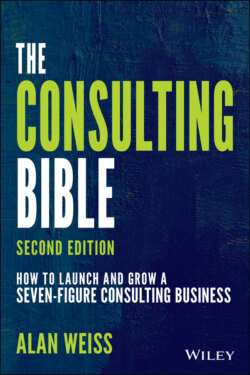Читать книгу The Consulting Bible - Alan Weiss - Страница 14
The Gospel
ОглавлениеIf you are a pair of hands and not a brain, then you're not a consultant. You're probably a very inexpensive employee.
FIGURE 1.3 Content, Processes, and Trust
I've personally mentored IT consultants all over the world, and have helped them to become true consultants, peers of their buyers, and charging for their value. But this is a tough sell. Most IT resources are simply performing tasks—writing code, fixing bugs, testing new relationships. They are not bringing their own intellectual capital or serving as partners and advisors to the chief information officer or chief technology officer (who should be their buyer).
Thus, the actual world supply of consultants is smaller than believed and the need is constantly growing, meaning that your potential to be in that top 20 percent is pretty high if you approach the profession with at least the diligence of a palm reader. That potential is growing as companies reduce residual talent. The greatest creator of net, new jobs in the U.S. (and in most countries) is small business. Large corporations reduce jobs through automation, attrition, and layoffs.
I've reproduced an earlier graph with more detail in Figure 1.3.
I advocated the diagonal approach earlier, and you can see that it's based on three factors, not just two:
1 The degree to which you bring useful content to the client.
2 The degree to which you bring useful processes to the client.
3 The degree to which you create trust with the buyer.
Content: The client is already immersed in content, which is often the problem—they are breathing their own exhaust. (I once had to remind officers at Mercedes‐Benz that they had auto experts falling out of the rafters, but that wasn't solving their customer service problems.) However, your ability to apply best practices from content you've been involved with elsewhere (and it doesn't have to be identical content, just analogous content) is highly valuable. The degree to which you move up the vertical axis depends on your interaction with the client, from sitting in a room by yourself to casual contact to public representation.
Process: You can superimpose processes that are universally applicable and that the client may be missing or simply not very good at. Most content‐heavy clients are not adept at the processes of conflict resolution, or priority setting, or strategy, simply because their time is overwhelmingly devoted to content matters. As you move along the horizontal axis, you once again move from “back stage” to “front stage.”
Trust: This is the key factor to propel you to the top right and become a true partner with your buyer. You can swiftly and efficiently build trust by:
Being introduced by a peer of the buyer.
Having a commercially published book(s).
Creating proprietary intellectual property and models.
Behaving and dressing like a successful businessperson.
Offering value early and frequently.
Being in the “public square” and known widely in the field.
Let me define trust: It is the honest‐to‐God belief that you're acting in the other person's best interest. That means that I'll accept even criticism well, because I know it's meant constructively. But if I don't trust you, I'll be wary even of compliments, worried about some hidden agenda on your part.
Consulting can take many forms, and it has in popular jargon. But I'm rejecting those who simply use the title because they are looking for full‐time work and those who are merely implementing as part‐time employees. That may sound elitist, but consulting is a noble profession, and we need to set some standards, since no one else seems to be doing so.
Let's see what success looks like.
